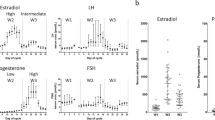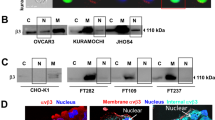Abstract
Oestrogen action is mediated via specific receptors that act as ligand-activated transcription factors. A monoclonal antibody specific to the C-terminus of human oestrogen receptor beta has been characterized and the prevalence of expression of oestrogen receptor beta protein investigated in a well defined set of breast cancers. Reverse transcription-polymerase chain reaction analysis of RNA from tissue biopsies detected oestrogen receptor beta in all samples examined. The anti-oestrogen receptor beta antibody cross reacted specifically with both long (∼59 Kd) and short (∼53 Kd) forms of recombinant oestrogen receptor beta. Western blot analysis of breast tumours contained both forms of oestrogen receptor beta protein although in some samples lower molecular weight species (32–45 Kd) were identified. Fifty-one breast cancer biopsies were examined using immunohistochemistry; 41 (80%) were immunopositive for oestrogen receptor alpha, 48 (94%) were immunopositive for oestrogen receptor beta and 38 (74.5%) co-expressed both receptors. Expression of oestrogen receptor beta was exclusively nuclear and occurred in multiple cell types. There was no quantitative relationship between staining for the two ERs although in tumours in which both receptors were present immunoexpression of oestrogen receptor alpha was invariably more intense. The significance of oestrogen receptor beta protein expression in breast cancers to therapy remains to be determined but the availability of a well characterized antibody capable of detecting oestrogen receptor beta in archive material will facilitate the process.
This is a preview of subscription content, access via your institution
Access options
Subscribe to this journal
Receive 24 print issues and online access
$259.00 per year
only $10.79 per issue
Buy this article
- Purchase on Springer Link
- Instant access to full article PDF
Prices may be subject to local taxes which are calculated during checkout





Similar content being viewed by others
References
Allred DC, Harvey JM, Berardo M, Clark GM (1998) Prognostic and predictive factors in breast cancer by immunohistochemical analysis. Mod Pathol 11: 155–168
Balleine RL, Hunt SMN, Clarke CL (1999) Coexpression of alternatively spliced estrogen and progesterone receptor transcripts in human breast cancer. J Clin Endocrinol Metab 84: 1370–1377
Barkhem T, Carlsson B, Nilsson Y, Enmark E, Gustafsson J, Nilsson S (1998) Differential response of estrogen receptor alpha and estrogen receptor beta to partial estrogen receptor agonists/antagonists. Mol Pharmacol 54: 105–112
Bollig A, Miksicek RJ (2000) An estrogen receptor-a splicing variant mediates both positive and negative effects on gene transcription. Mol Endocrinol 14: 634–649
Brandenberger AW, Lebovic DI, Tee MK, Ryan IP, Tseng JF, Jaffe RB, Taylor RN (1999) Oestrogen receptor (ER)-alpha and ER-beta isoforms in normal endometrial and endometriosis-derived stromal cells. Mol Hum Reprod 5: 651–655
Critchley HOD, Brenner RM, Drudy TA, Williams KA, Nayak NR, Millar MR, Saunders PTK (2001) Estrogen receptor beta, but not estrogen receptor alpha, is present in the vascular endothelium of the human and nonhuman primate endometrium. J Clin Endocrinol Metab 86: 1370–1378
Dotzlaw H, Leygue E, Watson PH, Murphy LC (1997) Expression of estrogen receptor-beta in human breast tumors. J Clin Endocrinol Metab 82: 2371–2374
Ekena K, Weis KE, Katzenellenbogen JA, Katzenellenbogen BS (1997) Different residues of the human estrogen receptor are involved in the recognition of structurally diverse estrogens and anti-estrogens. J Biol Chem 272: 5069–5075
Enmark E, Pelto-Huikko M, Grandien K, Lagercrantz S, Lagercrantz J, Fried G, Nordenskjold M, Gustafsson J-A (1997) Human estrogen receptor β-gene structure, chromosomal localization, and expression pattern. J Clin Endocrinol Metab 82: 4258–4265
Fuqua SA, Schiff R, Parra I, Friedrichs WE, Su JL, McKee DD, Slentz-Kesler K, Moore LB, Willson TM, Moore JT (1999) Expression of wild-type estrogen receptor beta and variant isoforms in human breast cancer. Cancer Res 59: 5425–5428
Green S, Walter P, Kumar V, Krust A, Bornert J-M, Argos P, Chambon P (1986) Human oestrogen receptor cDNA: sequence, expression and homology to v-erb-A. Nature 320: 134–139
Hall JM, McDonnell DP (1999) The estrogen receptor β-isoform (ERβ) of the human estrogen receptor modulates ERα transcriptional activity and is a key regulator of the cellular response to estrogens and antiestrogens. Endocrinology 140: 5566–5578
Huang A, Leygue E, Dotzlaw H, Murphy LC, Watson PH (1999) Influence of estrogen variants on the determination of ER status in human breast cancer. Breast Cancer Res Treat 58: 219–225
Iwao K, Miyoshi Y, Egawa C, Ikeda N, Tsukamoto F, Noguchi S (2000) Quantitative analysis of estrogen receptor-alpha and -beta messenger RNA expression in breast carcinoma by real-time polymerase chain reaction. Cancer 15: 1732–1738
Jarvinen TAH, Pelto-Huikko M, Holli K, Isola J (2000) Estrogen receptor β is co-expressed with ERa, and PR and associated with nodal status, grade and proliferation rate in breast cancer. Am J Pathol 156: 29–35
Jones PS, Parrott E, White INH (1999) Activation of transcription by estrogen receptor a and β is cell type- and promoter-dependent. J Biol Chem 274: 32008–32014
Jordan VC, Wolf MF, Mirecki DM, Whitford DA, Welshons WV (1988) Hormone receptor assays: clinical usefulness in the management of carcinoma of the breast. CRC Crit Rev Clin Lab Sci 26: 97–151
Kuiper GGJM, Carlsson B, Grandien K, Enmark E, Haggblad J, Nilsson S, Gustafsson J-A (1997) Comparison of the ligand binding specificity and transcript tissue distribution of estrogen receptors alpha and beta. Endocrinology 138: 863–870
Kuiper GGJM, Enmark E, Pelto-Hukko M, Nilsson S, Gustafsson J-A (1996) Cloning of a novel estrogen receptor expressed in rat prostate. Proc Natl Acad Sci USA 93: 5925–5930
Leake R, Barnes D, Pinder S, Ellis I, Anderson L, Anderson T, Adamson R, Rhodes T, Miller K, Walker R (2000) Immunohistochemical detection of steroid receptors in breast cancer: a working protocol. J Clin Pathol 53: 634–635
Leygue E, Dotzlaw H, Watson PH, Murphy LC (1998) Altered estrogen receptor a and β messenger RNA expression during human breast tumorigenesis. Cancer Res 58: 3197–3201
Lu B, Leygue E, Dotzlaw H, Murphy LC, Watson PH (1998) Estrogen receptor-β mRNA variants in human and murine tissues. Mol Cell Endocrinol 138: 199–203
Mann S, Laucirica R, Carlson N, Younes PS, Ali N, Younes A, Li Y, Younes M (2001) Estrogen receptor beta expression in invasive breast cancer. Human Pathol 32: 113–118
McGuire WL, Osborne CK, Clark GM, Knight WA (1982) Steroid hormone receptors and carcinoma of the breast. Am J Physiol 243: E99–E102
Miller WR (1996) Prediction of estrogen sensitivity/dependence. In Estrogen and Breast Cancer Miller WR (ed.) pp 151–169, Austin, Texas: Landes, RG
Moore JT, McKee DD, Slentz-Kesler K, Moore LB, Jones SA, Horne EL, Su JL, Kliewer SA, Leymann JM, Willson TM (1998) Cloning and characterisation of human estrogen receptor beta isoforms. Biochem Biophys Res Commun 247: 75–78
Mosselman S, Polman J, Dijkema R (1996) ERbeta: identification and characterization of a novel human estrogen receptor. FEBS Lett 392: 49–53
Norton AJ, Jordan S, Yeomans P (1994) Brief, high-temperature heat denaturation (pressure cooking): a simple and effective method of antigen retrieval for routinely processed tissues. J Pathol 173: 371–379
Ogawa S, Inoue S, Watanabe T, Hiroi H, Orimo A, Hosoi T, Ouchi Y, Muramatsu M (1998a) The complete primary structure of human estrogen receptor beta (hER beta) and its heterodimerization with ER alpha in vivo and in vitro. Biochem Biophys Res Commun 243: 129–132
Ogawa S, Inoue S, Watanabe T, Orimo A, Hosoi T, Ouchi Y, Muramatsu M (1998b) Molecular cloning and characterization of human estrogen receptor bcx: a potential inhibitor of estrogen action in human. Nucl Acids Res 26: 3505–3512
Omoto Y, Inoue S, Ogawa S, Toyama T, Yamashita H, Muramatsu M, Kobayashi S, Iwase H (2001) Clinical value of the wild type estrogen receptor β expression in breast cancer. Cancer Lett 163: 207–212
Pace P, Taylor J, Suntharalingam S, Coombes RC, Ali S (1997) Human estrogen receptor beta binds DNA in a manner similar to, and dimerizes with, estrogen receptor alpha. J Biol Chem 272: 25832–25838
Routledge EJ, White R, Parker MR, Sumpter JP (2000) Differential effects of xenoestrogens on coactivator recruitment by estrogen receptor (ER) α and ERβ. J Biol Chem 275: 85986–85993
Saji S, Jensen EV, Nilsson S, Rylander T, Warner M, Gustafsson J-A (2000) Estrogen receptors α and β in the rodent mammary gland. Proc Natl Acad Sci USA 97: 337–342
Saunders PTK, Millar MR, Macpherson S, Harkiss D, Anderson RA, Orr B, Groome NP, Williams K, Scobie G, Fraser HM (2000) Differential expression of estrogen receptor-alpha and -beta and androgen receptor in the ovaries in marmoset and human. Biol Reprod 63: 1098–1105
Scobie GS, Macpherson S, Millar MR, Groome NP, Romana PG, Saunders PTK (2001) Human estrogen receptors: differential expression of ERalpha and beta and the identification of ERbeta variants. Steroids (in press)
Speirs V, Parkes AT, Kerin MJ, Walton DS, Carleton PJ, Fox JN, Atkin SL (1999) Coexpression of estrogen receptor a and β: poor prognostic factors in human breast cancer. Cancer Res 59: 525–528
Sun J, Meyers MJ, Fink BE, Rajendran R, Katzenellenbogen JA, Katzenellenbogen BS (1999) Novel ligands that function as selective estrogens or antiestrogens for estrogen receptor-a or estrogen receptor-β. Endocrinology 140: 800–804
Vladusic EA, Hornby AE, Guerra-Vladusic FK, Lakins J, Lupu R (2000) Expression and regulation of estrogen receptor beta in human breast tumors and cell lines. Oncol Rep 7: 157–167
Vladusic EA, Hornby AE, Guerra-Vladusic FK, Lupu R (1998) Expression of estrogen receptor beta messenger RNA variant in breast cancer. Cancer Res 58: 210–214
Watanabe T, Inoue S, Ogawa S, Ishii Y, Hiroi H, Ikeda K, Orimo A, Muramatsu M (1997) Agonistic effect of tamoxifen is dependent upon cell type, ERE-promoter context, and estrogen receptor subtype: functional difference between estrogen receptors α and β. Biochem Biophys Res Commun 236: 140–145
Acknowledgements
We thank Dr Graeme Scobie for useful discussion and Dr D Stewart Irvine for assistance with statistical analysis.
Author information
Authors and Affiliations
Corresponding author
Rights and permissions
About this article
Cite this article
Saunders, P., Millar, M., Williams, K. et al. Expression of oestrogen receptor beta (ERβ1) protein in human breast cancer biopsies. Br J Cancer 86, 250–256 (2002). https://doi.org/10.1038/sj.bjc.6600035
Received:
Revised:
Accepted:
Published:
Issue Date:
DOI: https://doi.org/10.1038/sj.bjc.6600035
Keywords
This article is cited by
-
ERβ1: characterization, prognosis, and evaluation of treatment strategies in ERα-positive and -negative breast cancer
BMC Cancer (2014)
-
Estrogen receptor-beta sensitizes breast cancer cells to the anti-estrogenic actions of endoxifen
Breast Cancer Research (2011)
-
Early Detection of Breast Cancer: Synthesis and Characterization of Novel Target Specific NIR-Fluorescent Estrogen Conjugate for Molecular Optical Imaging
Journal of Fluorescence (2011)
-
Estrogen receptor-β expression in invasive breast cancer in relation to molecular phenotype: results from the Nurses' Health Study
Modern Pathology (2010)
-
Oestrogen receptor β and neoadjuvant therapy with tamoxifen: prediction of response and effects of treatment
British Journal of Cancer (2006)



